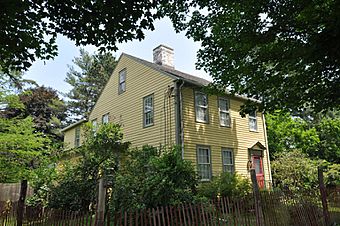Ross Farm (Northampton, Massachusetts) facts for kids
Quick facts for kids |
|
|
Ross Farm
|
|
 |
|
| Location | Northampton, Massachusetts |
|---|---|
| Built | 1825 |
| Architectural style | Federal |
| MPS | Underground Railroad in Massachusetts MPS |
| NRHP reference No. | 07001360 |
| Added to NRHP | January 8, 2008 |
Ross Farm is an old farmhouse located in Northampton, Massachusetts. It's a special place because it was once home to a unique community from 1841 to 1845. This farm was also an important stop on the Underground Railroad, a secret network that helped enslaved people find freedom. The farmhouse was built in 1825. It used to be part of a much larger property, but now it's a smaller piece of land with just the historic house.
History of Ross Farm
The Ross Farmhouse was built in 1825 by Thomas Burt. His family had owned the land since 1798. The house looks like many homes from that time, with a central chimney. It still has many of its original parts, even though some changes have been made over the years.
In 1834, Thomas Burt sold the farm to Samuel Whitmarsh. Mr. Whitmarsh made the property much bigger. He planted mulberry trees and built a silk factory near the Mill River. Later, he sold the house and a large part of the land to a group called the Northampton Association for Education and Industry (NAEI).
The NAEI Community at Ross Farm
The NAEI used the farm as a place for people to live and work together. This was an experiment in "communal living," where everyone shared resources and responsibilities. The NAEI ran the silk factory and also had a school, a store, and homes for its members. This community was active until 1845.
After the NAEI, Austin Ross bought the farm. His family owned the property until 1902. The farm is now listed on the National Register of Historic Places, which means it's recognized as an important historical site.
Ross Farm and the Underground Railroad
The NAEI was part of a movement in the 1840s where many groups tried living in communities. One of the leaders of the NAEI was George Benson. He was the brother-in-law of William Lloyd Garrison, a famous leader who fought against slavery.
The NAEI community believed in equality for everyone. Most of its members were "abolitionists," meaning they wanted to end slavery. They were special because they welcomed African Americans into their community, which was rare at that time. One famous person who lived there was Sojourner Truth, a powerful speaker and abolitionist.
Ross Farm became a well-known and important stop on the Underground Railroad. This was a secret network of safe houses and routes that helped enslaved people escape to freedom in the North. Austin Ross, who bought the farm later, was also an abolitionist. He continued to use the farm as a station on the Underground Railroad, helping many people on their journey to freedom.



